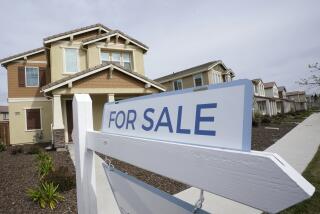Obama to unveil $75-billion mortgage relief plan
WASHINGTON AND MESA, ARIZ. — President Obama unveiled a $75-billion federal plan to ease the epidemic of home foreclosures Wednesday, casting it as a lifeline for as many as 9 million homeowners and a means for ending the downward spiral of the economy.
The housing market collapse helped trigger the broader economic decline, the president argued, and so acting “boldly and swiftly” to arrest a wave of foreclosures would have positive effects across the economy and benefit every American.
“In the end, all of us are paying a price for this home mortgage crisis,” Obama said. “And all of us will pay an even steeper price if we allow this crisis to deepen, a crisis which is unraveling homeownership, the middle class and the American dream itself.”
Obama presented the plan at a high school outside Phoenix, in a state where about one out of every 182 homes faced some stage of foreclosure proceedings last year. Nationwide, there were 2.2 million foreclosures last year, and the administration expects as many as 6 million foreclosures in the “coming years,” said Shaun Donovan, secretary of Housing and Urban Development.
The president’s proposal aims to assist two broad classes of homeowners.
The administration says the plan will help as many as 5 million people whose homes have lost so much value that they cannot qualify for conventional refinancing to take advantage of today’s low interest rates. Under the plan, eligible homeowners could switch to lower-rate mortgages through Fannie Mae or Freddie Mac, the home loan giants, and potentially cut thousands of dollars from their payments each year.
In addition, the administration intends to help as many as 4 million homeowners at risk of foreclosure because of job losses or other effects of the recession, or because of increases in adjustable-rate mortgages.
The goal is to bring mortgage payments down to a more reasonable level, defined as 31% of monthly income. It will cost $75 billion, which would come from the $700-billion financial services industry bailout that Congress approved last year.
The plan gives financial incentives to lenders and mortgage servicing companies to encourage them to help people refinance.
In addition, Obama’s plan would use money already approved by Congress to enlarge the government commitment to Fannie Mae and Freddie Mac “to ensure the strength and security of the mortgage market,” the administration said.
The housing initiative is shaping up to be the most politically palatable component of Obama’s larger plan to fix the economy, which includes the $787-billion stimulus package he signed this week and rescue plans for the financial services sector and the auto industry. Even Republicans who have opposed other parts of Obama’s solution were reluctant to be too critical of the housing plan Wednesday.
Still, the introduction of another multibillion-dollar plan drew a cautious response from some members of Congress, who are already suffering what some have called “bailout fatigue.” House Republican leaders sent a letter to Obama posing questions about the housing proposal, opening with a query about how the plan would help “the over 90% of homeowners who are playing and paying by the rules.”
The plan is far more detailed than the bank rescue proposal the administration rolled out last week, which was criticized for being vague and blamed for an immediate plunge in the stock market.
In arguing for the plan, Obama said foreclosures hurt more than the homeowners involved.
“There are families who see ‘for sale’ signs lining the streets, who see neighbors leave and homes standing vacant and lawns slowly turning brown,” Obama said. “They see their own homes, their largest single assets, plummeting in value.”
Economists say some form of foreclosure relief could play a crucial part in an overall economic recovery.
“All of these foreclosures are weighing down the value of housing, and that’s undermining consumer confidence,” said Ken Rosen, chairman of the Fisher Center for Real Estate and Urban Economics at UC Berkeley. “If you stabilize housing prices, that’s very important to all the people who own houses and their confidence to spend.”
In addition, he said, aid to homeowners would have a direct effect on the beleaguered banking industry.
“Three-quarters of the assets going bad in banks are home mortgages,” Rosen said. “By doing loan modification rather than foreclosure, you’re saving probably 50% of their loss. Half their loss will not happen.”
Democratic members of Congress greeted Obama’s proposal warmly. House Speaker Nancy Pelosi (D-San Francisco) called it “essential to get our economy moving again.”
Sen. Christopher J. Dodd (D-Conn.), chairman of the Senate Committee on Banking, Housing and Urban Affairs, said the Obama administration “gets it.”
“Foreclosure prevention not only provides relief to middle-class families struggling to make ends meet,” Dodd said, “but also is critical to getting our economy back on track.”
--
More to Read
Get the L.A. Times Politics newsletter
Deeply reported insights into legislation, politics and policy from Sacramento, Washington and beyond. In your inbox three times per week.
You may occasionally receive promotional content from the Los Angeles Times.











